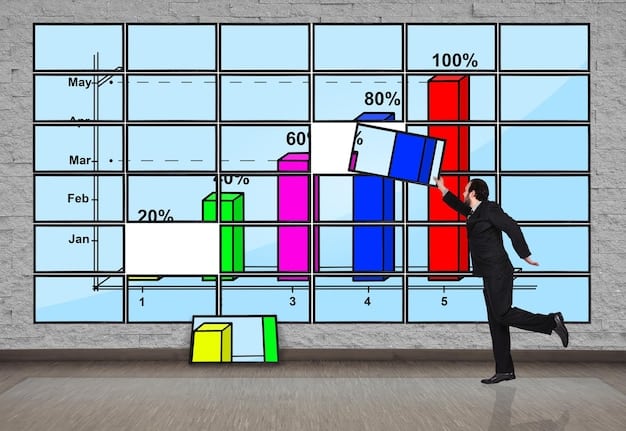Timeless Reports: Building a Storm-Proof Investment Portfolio

Timeless Reports offer strategies for constructing investment portfolios designed to withstand economic downturns by focusing on asset allocation, diversification, and long-term growth, ensuring financial resilience regardless of market conditions.
Navigate economic uncertainties with confidence. Timeless Reports provide actionable insights into building a resilient portfolio that remains strong no matter the economic storm. Learn how to position your investments for long-term success.
Understanding Timeless Reports for Portfolio Resilience
Timeless Reports focus on investment strategies designed to endure various economic cycles. They emphasize long-term financial planning rather than short-term gains.
These reports delve into key aspects of portfolio construction, risk management, and asset allocation, providing investors with strategies to navigate economic uncertainties effectively.
The Essence of Diversification
Diversification is a cornerstone of resilient portfolios. It involves spreading investments across various asset classes to mitigate risk.
- Asset Allocation: Distribute investments across stocks, bonds, real estate, and commodities.
- Sector Diversification: Invest in multiple sectors to avoid overexposure to any single industry.
- Geographic Diversification: Include international assets to reduce dependence on a single economy.
Proper diversification can cushion the portfolio during market downturns and enhance long-term returns.
Asset Allocation Strategies for Economic Resilience
Asset allocation determines how your portfolio is divided among different asset classes. A well-defined asset allocation strategy is critical for withstanding economic storms.
Consider your risk tolerance, investment timeline, and financial goals when determining your asset allocation. Adjust your portfolio regularly to maintain the desired balance.

Balancing Risk and Return
A resilient portfolio balances risk and return by combining asset classes with varying risk profiles. This approach aims to maximize returns while minimizing potential losses during volatile periods.
- Conservative Allocation: Primarily bonds and dividend-paying stocks for stable income.
- Moderate Allocation: Balanced mix of stocks and bonds for moderate growth and income.
- Aggressive Allocation: Mostly stocks for high growth potential, suitable for long-term investors.
Regularly review and rebalance your portfolio to stay aligned with your risk tolerance and investment objectives.
Selecting Investments That Withstand Market Volatility
Choosing the right investments is key to building a portfolio that can weather any economic condition. Focus on companies with strong financials and proven track records.
Consider investing in sectors that are less sensitive to economic cycles, such as healthcare, consumer staples, and utilities.
Quality Over Quantity
Prioritize quality investments with solid fundamentals. Companies with strong balance sheets, consistent earnings, and competitive advantages are more likely to perform well over the long-term.
Look for companies that have a history of weathering economic downturns and maintaining profitability even during challenging times.

Investing in high-quality assets can provide stability and resilience to your portfolio during market fluctuations.
Risk Management Techniques for a Resilient Portfolio
Effective risk management is essential for protecting your portfolio against unexpected losses. Implement strategies to mitigate potential risks.
Use stop-loss orders to limit losses on individual investments and consider hedging strategies to protect against market downturns.
Diversify Beyond Traditional Assets
Explore alternative investments such as real estate, commodities, and precious metals to further diversify your portfolio. These assets can provide a hedge against inflation and economic uncertainty.
- Real Estate: Investments in property can provide a stable income stream and potential capital appreciation.
- Commodities: Raw materials such as gold and silver can act as a hedge against inflation.
- Precious Metals: Historically, precious metals have maintained their value during economic downturns.
Diversifying into alternative assets can enhance the resilience of your portfolio.
Continuous Monitoring and Adaptation
Building a resilient portfolio is not a one-time task. It requires continuous monitoring and adaptation to changing economic conditions.
Regularly review your portfolio’s performance and make necessary adjustments to maintain your desired asset allocation. Stay informed about economic trends and market developments.
Adjusting to Economic Shifts
Be prepared to adjust your portfolio in response to economic shifts. This may involve rebalancing your asset allocation, re-evaluating your investment choices, and implementing new risk management strategies.
Stay flexible and adapt your investment approach to changing market conditions. A proactive approach can help you navigate economic challenges effectively.
Regularly monitoring and adapting your portfolio ensures it remains aligned with your financial goals and risk tolerance.
The Role of Education and Professional Advice
Investing can be complex, particularly in uncertain economic times. Seek education and professional advice to make informed decisions.
Consider consulting with a financial advisor who can provide personalized guidance based on your specific circumstances. Stay informed through reliable sources and educational resources.
Empowering Through Knowledge
Educate yourself about investment strategies, risk management, and economic trends. The more you know, the better equipped you will be to make sound investment decisions.
- Financial Literacy: Understanding basic financial concepts is crucial for effective investment management.
- Market Analysis: Keeping abreast of market trends and economic indicators can inform your investment decisions.
- Professional Guidance: Consulting with a financial advisor can provide valuable insights and personalized advice.
Knowledge is power when it comes to building and maintaining a resilient portfolio.
| Key Point | Brief Description |
|---|---|
| 🛡️ Diversification | Spreading investments across various asset classes to minimize risk. Diversify across asset classes, industries and geography. |
| 📈 Quality Assets | Investing in companies with strong balance sheets and consistent earnings. Quality over quantity. |
| 📊 Risk Management | Implementing strategies like stop-loss orders and hedging to protect against losses. Diversify beyond traditional assets. |
| 🔍 Continuous Monitoring | Regularly reviewing and adjusting your portfolio to adapt to changing economic conditions. Stay informed and proactive. |
FAQ
▼
A Timeless Report provides actionable insights for building a resilient investment portfolio that can withstand various economic cycles, emphasizing long-term financial planning over short-term gains.
▼
Diversification spreads investments across different asset classes, industries, and geographies to reduce the impact of any single investment’s poor performance on the overall portfolio, mitigating risk.
▼
Asset allocation is the process of dividing your portfolio among different asset classes, such as stocks, bonds, and real estate, based on your risk tolerance, investment timeline, and financial goals. It’s crucial for balancing risk and return.
▼
Quality investments include companies with strong balance sheets, consistent earnings, and competitive advantages. These are more likely to perform well long-term and withstand economic downturns, offering stability.
▼
Continuous monitoring allows you to adapt to changing economic conditions, rebalance your asset allocation, and implement new risk management strategies, ensuring your portfolio stays aligned with your goals.
Conclusion
Building a resilient portfolio that can withstand any economic storm requires a blend of diversification, quality investments, effective risk management, and continuous monitoring. By following the strategies outlined in Timeless Reports, you can create a financial foundation that stands strong regardless of market conditions, securing your long-term financial future.





